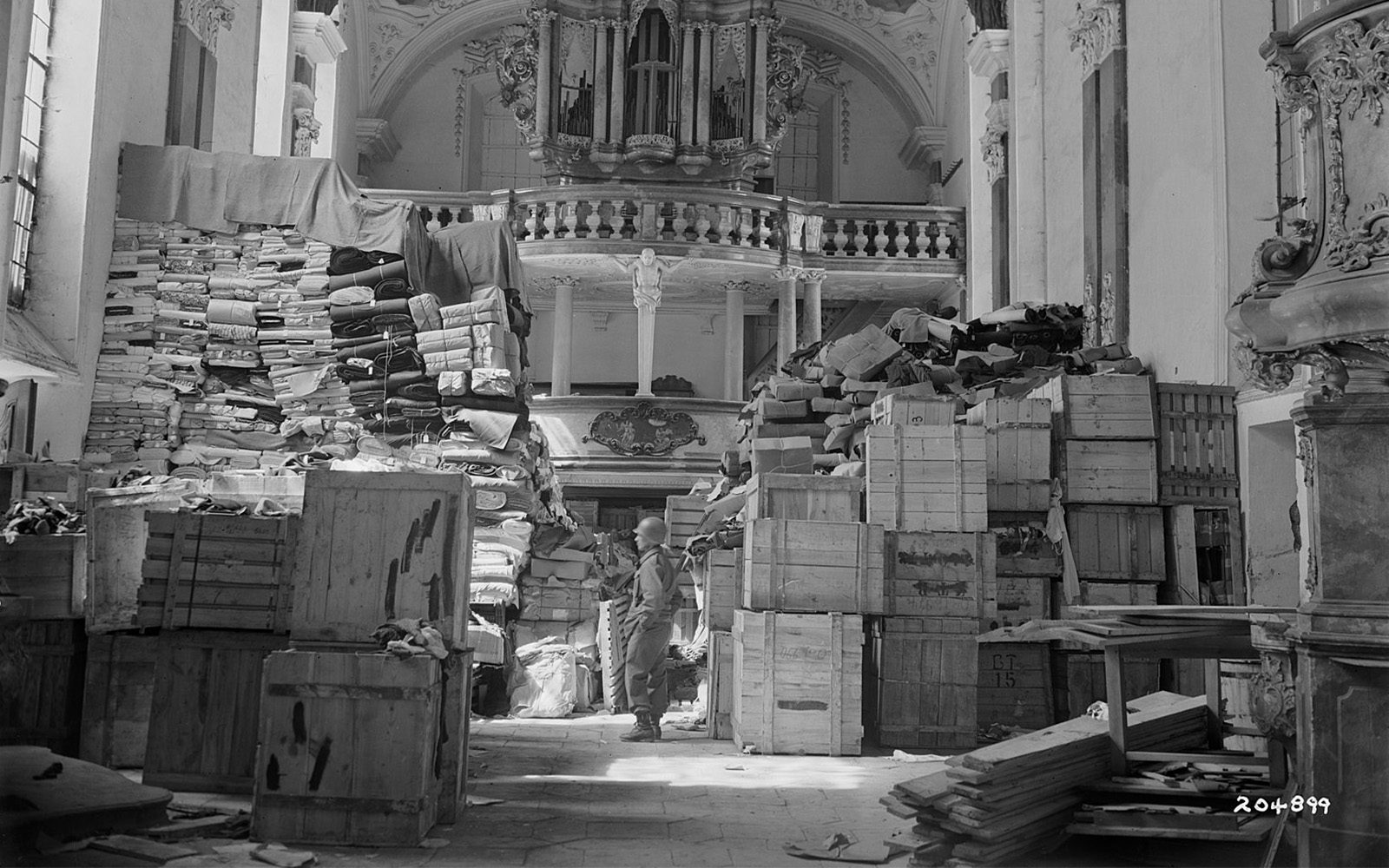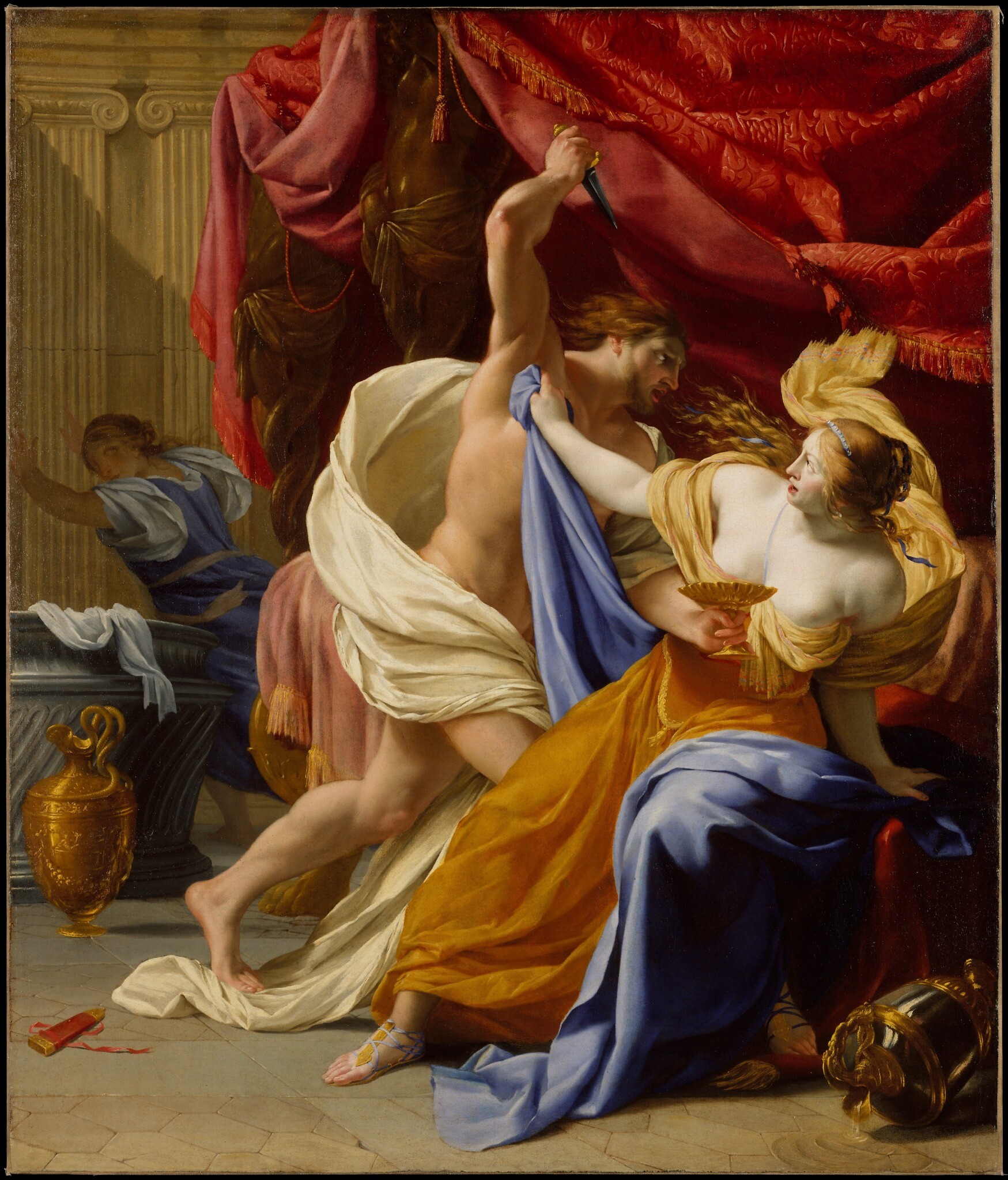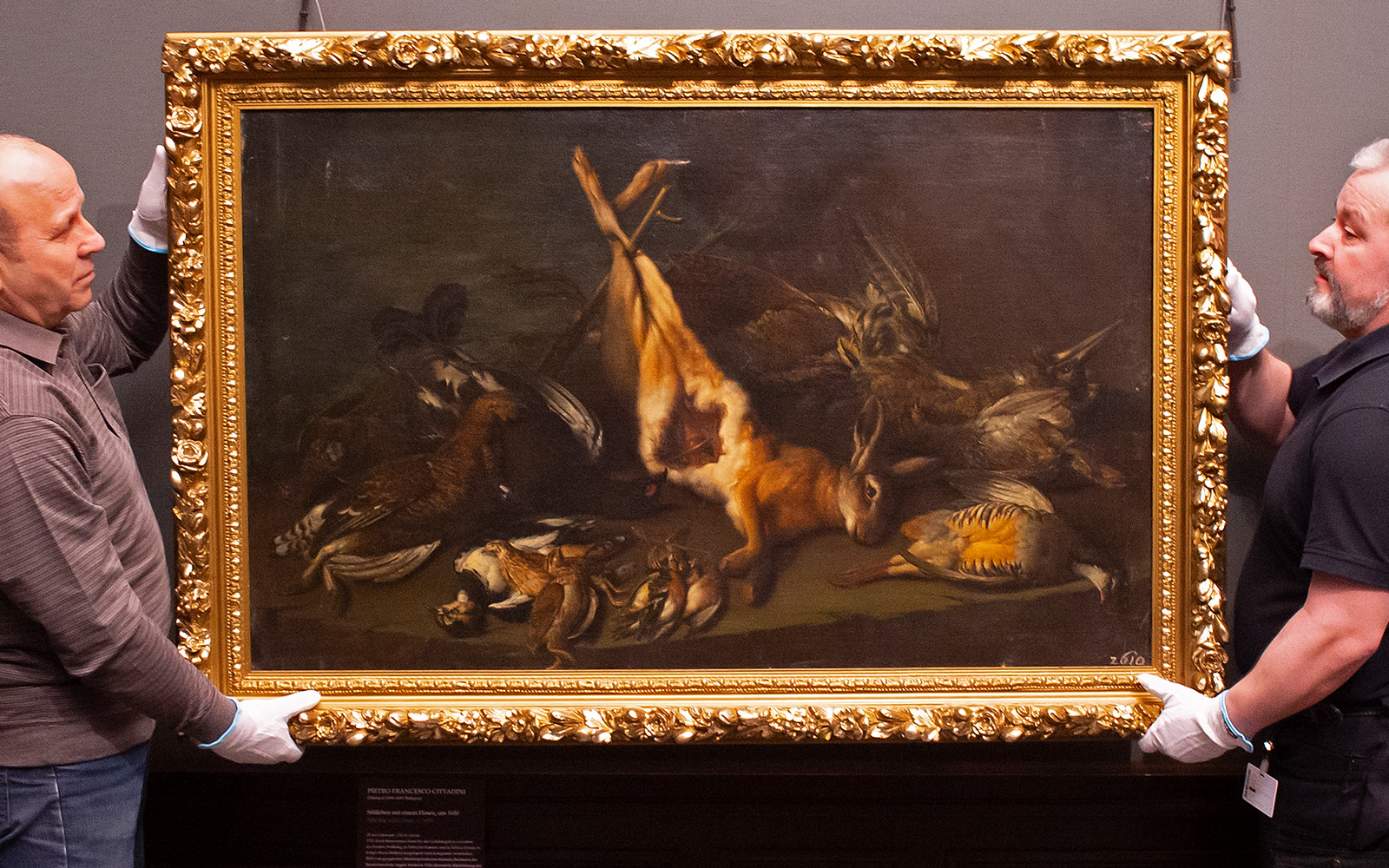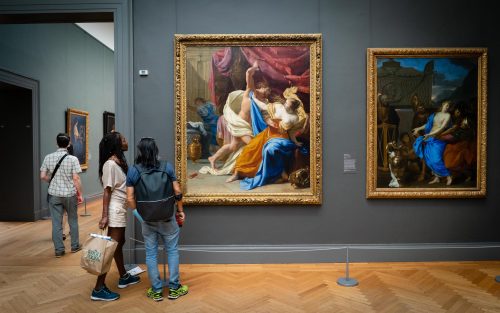The arresting, 6-foot tall image in New York’s Metropolitan Museum of Art is displayed among gallery 621’s other Baroque masterpieces. Visitors pause to read a placard identifying the scene as “The Rape of Tamar,” painted around the year 1640 by the French artist Eustache Le Sueur.
The legislation aims to combat widespread Holocaust ignorance in New York State by informing the public about this lesser-known aspect of the genocide, and will also pressure museums and the art world to continue addressing Nazi-looted art, although the law’s implementation remains unclear. It is a state education law, and is not aimed at restitution efforts.
Around 600,000 pieces of art were taken from Jews under Adolf Hitler’s regime, hundreds of which likely remain in New York museums. The Nazis wanted to strip the Jewish people of its wealth and heritage, culturally enrich the Third Reich and its leadership, who took valuable pieces for its own collections. Paintings that were deemed degenerate were sold for foreign currency or destroyed. In many cases, Jews sold off artwork to non-Jewish civilians under duress.
“The thrust of this legislation is to reach the greatest number of people, alert them to the fact that these wondrous works of art have blood on them,” said New York State Assembly member Charles Lavine, who sponsored the law with New York State Senator Anna Kaplan. The bill is believed to be the first of its kind in any country.
Dark history and modern hatred
Lavine and Kaplan told The Times of Israel their personal stories inspired the legislation. Lavine’s grandmother lost 12 of her siblings in the Nazi genocide, and Kaplan is a Jewish political refugee from Iran.
The lawmakers began looking for a way to boost Holocaust awareness after surveys showed younger New Yorkers did not know the basic facts about the genocide. A 2020 survey by the Claims Conference, which represents Jews seeking compensation for the Holocaust, found that 60% of New Yorkers did not know six million Jews were murdered; 58% could not name a single concentration camp; 19% believed Jews caused the Holocaust; and 43% did not know what Auschwitz was.
“The meaning of this bill is to make sure to bring awareness that this art, that this piece of art had been stolen from a Jewish home or a Jewish organization,” Kaplan said. “It wasn’t just killing Jews; it was also trying to use their wealth and stealing their wealth to fund their goal and to eliminate Jewish identity and Jewish culture.”

Hochul stressed the need to remember the Holocaust, and to combat the high rate of anti-Jewish hate crimes in New York, as she signed the laws in the presence of Lavine, Kaplan and survivors. New York City is home to more survivors than any other city, and the state has the largest Jewish population outside of Israel. Jews are targeted in hate crimes in New York far more than any other group, with antisemitic incidents happening nearly every day.
“‘Never forget’ is more than a slogan. It’s what we preach, but I want to make sure it’s really being taught,” Hochul said.
The legislation will require museums with works of art stolen during the Nazi era in Europe to “prominently place a placard acknowledging such information along with the display,” the law says. “Many museums now display this stolen art with no recognition of their provenance.”
The law says the museums should place the placard “to the extent practicable,” potentially giving them a way to duck the rule. Museums could also take down art they do not want to label.

“You have to be proactive. It’s not ‘Never forget,’ it’s ‘Remember’
“It opens up another avenue, another opportunity, for people who might not otherwise think about the Holocaust or really understand the breadth, the depth, the extent of the Holocaust and what happened,” said Gregory Schneider, the executive vice president of the Claims Conference. “You have to be proactive. It’s not ‘Never forget,’ it’s ‘Remember.’ You have to do things to remember.”
The law came into effect immediately, but how it will play out is still unclear. It requires each individual piece of stolen art to be accompanied by a sign or placard explaining its “dark history,” Kaplan said, meaning a generalized acknowledgment in a gallery will not be sufficient. Museums will decide how to phrase the text and where to place the placard, and there are no penalties for noncompliance. No museums have announced any plans for implementation.
The bigger question is which pieces of art, and how many, will fall under the law’s purview.

The murky past
Of the hundreds of thousands of artworks plundered under the Nazis, the whereabouts of many are still unknown.
A Holocaust Era Assets conference in the Czech Republic in 2009 put the number of stolen artworks at 650,000, and estimated that 100,000 had not been returned
It wasn’t until the 1990s that online databases and digitized records made tracking and sharing information about art’s provenance, or history of ownership, widely accessible.
A Holocaust Era Assets conference in the Czech Republic in 2009 put the number of stolen artworks at 650,000, and estimated that 100,000 had not been returned.
“It’s hard to quantify because you don’t know what you don’t know. There’s no full database of everything that’s even been restituted,” Schneider said. Most unclaimed art stolen from Jews likely remains in European museums and in private collections, he said.
In New York, museums were already required to register artwork believed stolen under the Nazis with the Art Loss Register online database. The American Alliance of Museums and the Association of Art Museum directors have guidelines that urge museums to research Nazi-era provenance in their collections, meaning artwork that changed hands during Hitler’s reign, and if they uncover looting, to make that information public and reach out to potential claimants.
The American Alliance of Museums maintains the Nazi-era Provenance Internet Portal, which registers Nazi-era provenance artwork. It lists close to 30,000 objects at 179 participating museums, including 16 museums in New York with 2,370 Nazi-era pieces.

Thus, the law relating to theft, seizure and forced sales might directly apply to several hundred pieces in New York museums at a given time, but may include some trophy pieces.
“There were many different ways art was lost during this time. There was wartime theft that was deliberate but often haphazard, there was actual looting and confiscation by Nazi troops, there were forced sales,” said Victoria Reed, the lead provenance researcher at the Museum of Fine Arts, Boston.
The status of the art today also varies. Some was looted during the war, then recovered and restituted soon after; other pieces are in the process of being restituted, or are the subject of legal battles; and there are objects that were stolen, and remain that way.
Determining forced sales, or sales that were made under duress, is especially difficult. Jewish collectors were sometimes forced by the Nazis to auction off their belongings, or sell directly to the Nazi government. In other cases, they sold property as they fled persecution to non-Jews, who exploited the situation by paying them less than the purchased objects were worth.

The research is expensive and time-consuming, as researchers may need to travel back and forth between the US and Europe to dig into different archives, and there are few people with the necessary expertise. Even with all the facts, different parties may come to different conclusions about a particular case.
For “The Rape of Tamar,” court records unearthed several years ago indicated that it was owned by a Jewish art dealer, Siegfried Aram, who fled Germany for the US in 1933. Aram argued in courts after the war that he had been taken advantage of because he was Jewish, and forced to sell his home for less than it was worth as the Nazis stepped up persecution. The businessman who bought it, Oskar Sommar, illegally took the painting along with the home, said Aram, who died in the 1970s.
Said Kaplan: If there is any doubt about the Nazi-era provenance of a particular piece, it should be labeled
After the war, Aram battled to retrieve the painting for years in Germany, to no avail. Sommar’s descendants argued the businessman had acquired the property legally, and the government said it was not responsible. Sommar’s family sold the painting at auction in 1983, leaving Aram’s name out of provenance records, and the Met acquired it months later, The New York Times reported.
The facts only came to light due to an independent German researcher. Now, the painting’s page on the museum’s website has a dropdown menu that says the painting was sold to Sommar “as a contested part of his purchase of Aram’s villa.”

Response and restitution
The Met, the Guggenheim, and the Museum of Modern Art, which have the largest number of Nazi-era provenance pieces in New York, did not disclose specific plans for implementing the law when contacted by the Times of Israel. All three have provenance research projects that look into possible Nazi-era looting.
The Museum of Modern Art said it knew of no relevant pieces in its collection, but would review the legislation and pursue compliance. The Met said it “has a long and well documented history of being transparent regarding works of art sold during the Nazi era and seeking resolution for any object that has been identified as illegally appropriated without subsequent restitution.” The Guggenheim did not respond to a request for comment. New York museums are seen as generally compliant with Nazi-era provenance regulations and have restituted artwork in the past, but their efforts have gotten mixed reviews from experts who spoke with The Times of Israel.

“Let’s be realistic. Mr. Smith, the local billionaire, comes to you. You’re a museum director. He says, ‘Look at my fabulous collection of Picassos and Monets. Don’t you want it in your museum?’”
“Do you have the chutzpah to say, ‘Oh, well, where’d you get it all?’ The reality is no. ‘Put it in your will, leave it to us, we’ll name a wing after you,’” Dowd said. “Their job is to accept donations and let rich people have tax breaks.”
The new law will likely slow the flow of Nazi-looted art into museums and give curators better footing for calling out malfeasance
Once the art is in a collection, finding out a crime was committed in its past is an embarrassment for the museum and the donors, and can have legal repercussions. Curators and lower managers at museums often want to do the right thing, but don’t want to directly criticize their superiors, he said.
The new law will likely slow the flow of Nazi-looted art into museums and give curators better footing for calling out malfeasance, he said.
Schneider, from the Claims Conference, said the new law was groundbreaking for education, which is its main intent, but “in terms of restitution, it’s not revolutionary.”
Heirs have already been able to find specific pieces in US museums via online databases, but will only pursue a complicated and costly legal battle to retrieve artwork if it’s an extremely valuable piece. A US lawsuit over a Camille Pissarro painting has stretched on for over 17 years. Other countries have different procedures for restitution that are also legally complex, especially since so much documentation has been lost.

If an entire family was wiped out during the war, leaving no heirs, the artwork will remain in a museum. Most countries follow a law doctrine called escheat, which says that when a person dies without heirs, their property reverts to the government where they lived. That means countries such as Poland or Hungary, which collaborated with the Nazis, are profiting off that collaboration by holding Jewish property, including artwork. The plundered paintings are worth billions and confiscated Jewish real estate was even more valuable.
Heirs have waged court battles over treasures by luminaries including Pablo Picasso, Vincent Van Gogh, Gustav Klimt, Claude Monet, Wassily Kandinsky, Edgar Degas and Henri Matisse.
Major court decisions have gone both ways in the US and Europe. The Met won a lawsuit in 2018 from a family seeking the return of a Picasso called “The Actor.” A US federal judge said the family of Paul Leffman, a Jewish businessman, did not adequately show he sold it under duress while fleeing Germany in 1937.
In 2009, The Museum of Modern Art and the Guggenheim both settled with the heirs of a Jewish collector who they said had sold off his collection under Nazi pressure. The museums kept two prominent Picassos as part of the settlement. Another case against the Museum of Modern Art was dismissed in 2010.
Last week, a US court threw out a lawsuit against a German museum foundation that was filed by heirs of Nazi-era Jewish art dealers, saying that the US lacked jurisdiction to hear such a case.
The Met has restituted or reached settlements for eight objects, including a Monet, and its collection includes 53 pieces that were looted by the Nazis and subsequently returned to their owners, which the new law is supposed to cover.

The bigger picture
The reckoning with art looted from Jews and others has gained ground in recent decades. Forty-four countries signed the Washington Declaration in 1998, which committed them to step up efforts to return plundered pieces to owners or heirs. The declaration led to new laws, including the US Holocaust Expropriated Art Recovery Act of 2016, which lengthened the time limit for filing a restitution claim.
New York’s Jewish Museum held an exhibition of looted art and objects last year that generated new research on the topic, and said it already includes Holocaust information on some of its placards. The museum applauded the new law and said looted art “can possess a restorative and educational power that can only be fulfilled when their actual histories are known.”
European museums including the Louvre in Paris have made restitution efforts in recent years and exhibited collections of looted art to raise awareness.
The New York bill’s sponsors hope it leads to similar legislation requiring labeling in other states and countries. The effort is particularly important now, with the “specter of totalitarianism” on the rise in the US and Europe, Lavine said.
‘If you’ve gotten away with it so far, it doesn’t mean you’re going to continue to get away with it. You have to continue to look at your collection’
New York is the center of the art market in the US, and home to many museums, meaning the law could have a wider impact and keep a spotlight on the issue. The law has drawn the attention of the art world, as well as Jewish groups.
“It continues to put pressure on museums, to say that this is an important issue. If you’ve gotten away with it so far, it doesn’t mean you’re going to continue to get away with it. You have to continue to look at your collection,” said Schneider, adding that more needs to be done about looted art in private collections.
Nazi-era research and restitution has cleared the way for other groups in the past, starting with the democratization of provenance information online in the late 1990s, said Reed, the Boston provenance researcher. “It affected a sea change,” she said. The museum guidelines pertaining to Nazi-era losses were the first that required museums to make provenance information public. There are now efforts to repatriate items including archaeological finds to Italy and Greece, and objects looted by colonial powers to Nigeria, Cambodia and Native American groups.
“Do we care about the people who owned and created this object? If you’re going into museums, going ‘Here’s a pretty picture,’ and there’s a blank wall, it’s like the object matters but the people don’t”
“I thought the museum of the future would have as much information on the provenance and pay attention to that as to the aesthetics of it,” said Dowd. “Do we care about the people who owned and created this object? If you’re going into museums, going ‘Here’s a pretty picture,’ and there’s a blank wall, it’s like the object matters but the people don’t.”
“That’s the message and it’s a horrible message,” he said. “This law is a really good shot in the arm for people who care about this and I think it will help keep the issue front and center.”
At the Met, visitors glance at the small gray placard next to “The Rape of Tamar.” It notes how sculpture influenced the artist, that he co-founded France’s Académie Royale and that the painting was purchased in 1984.
“A pervasive classicism tempers the violence of this scene,” the museum-goers read, before continuing on.
Confira também:
- Galleria Borghese: um dos museus mais fascinantes da Itália
- Moda na Casa Museu Ema Klabin
- A situação das mulheres na Ucrânia e no mundo
Fique por dentro das novidades com o #TrendsCHK.
Siga a gente nas redes sociais @trendschk.




